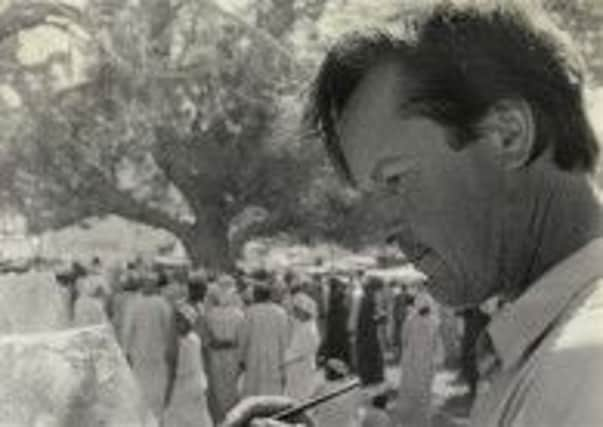Obituary: Julian Barrow, landscape and country house artist


Julian Barrow was an established and widely collected painter of town and landscapes and specialised in captivating canvases of country houses. He painted mostly in oils and executed more than 1,000 pictures in his career. His style was defiantly traditional but his skill in matching colours gave his paintings real energy and a beguiling charm and warmth. Barrow loved the countryside and depicted fine houses amidst glorious countryside. But he also displayed a deft touch for urban scenes – especially in London, New York and Paris.
His New York agent, Harriet Bridgeman, commented recently: “Julian was charming, always welcoming, diplomatic and quietly enthusiastic. The sort of person one is always so happy to see.”
Advertisement
Hide AdAdvertisement
Hide AdBarrow painted often in Scotland – mostly castles and country houses although he did a fine portrait of Alexander Chinnery-Haldane, Laird of Gleneagles. Barrow places his subject at ease in a comfortable armchair with the Scottish hills in the background. There is a delightful air of contentment and calm about the portrait.
Julian Gurney Barrow’s father was a solicitor who worked for Carr’s Biscuits in Carlisle and later for the Board of Trade in London. His mother, the distinguished artist Margaret MacInnes, had studied at the Edinburgh College of Art.
Barrow spent most of the war years in Dacre, near Ullswater.
Even before he arrived at Harrow he showed talent as a draughtsman.
This was much enhanced at Harrow where he won the Henry Yates Thompson Art Prize on three occasions. He was turned down for national service on medical grounds and instead enrolled at the Royal West of England Art College in Bristol.
Barrow did not take easily to classes and instead, in 1958, went to London to work with a Bond Street picture restorer. He spent many months restoring the original picture of a dog beside a wind-up gramophone horn which was the famous logo for His Master’s Voice.
Barrow then joined the restoration department of the National Gallery in Trafalgar Square and they sent him on a restoration project in Ireland. While there he found inspiration in the surrounding hills and he painted in his spare time.
He decided to forsake restoring and become a full-time artist. In 1960 Barrow studied with Pietro Annigoni (famed for his 1956 romantic portrait of the Queen) in Florence.
Advertisement
Hide AdAdvertisement
Hide AdHe rented a studio in Chelsea and one of his first commissions was to paint the hero of the King’s Own Scottish Borderers Sgt Bill Speakman, VC who had won his award in Korea in 1951.
In 1966 Barrow held his first exhibition in New York and also painted a portrait of Mrs Vincent Astor in her Manhattan drawing room.
In the early 1970s Barrow received many offers to paint the houses of some fine Scottish castles and mansions. He had several Scottish patrons; he painted Colin Tennant’s baronial mansion, Glen, in Peeblesshire and The Old Manse at Balfron, Stirlingshire with its white-walled exteriors framed in the picture by two magnificent oak trees. There is a great feeling of tranquility about both works and Barrow lets the light play wistfully on the distant hills.
Two other impressive Scottish oils from this period include Fyvie Castle in Aberdeenshire and A Scottish Lodge, Angus which depicts the lodge nestling in a copse of trees. Barrow brings to the latter a colourful serenity that is often to be found in his landscapes.
Commissions in the south included Howard Castle in Yorkshire and Badminton for the Duke of Beaufort.
But Barrow loved painting and was just as happy to capture the light playing on inner city shop fronts – such as the Mayfair hatters, Lock & Co and the vintners Berry Bros – and especially the bridges over the Thames. Barrow travelled widely and much enjoyed painting in Tuscany, Venice and Paris.
For much of his career Barrow lived in Tite Street in Chelsea, overlooking the Thames.
It was a Victorian building that had been occupied by John Singer Sargent, Rex Whistler and Augustus John. The latter painted his famous portrait of Field Marshal Bernard Montgomery in the studio – it now hangs in the Hunterian Museum in Glasgow.
Advertisement
Hide AdAdvertisement
Hide AdFor the Queen’s Silver Jubilee in 1977 he produced a portrait of the House of Lords which now hangs at Westminster and embarked on a series of interiors of London clubs such as the Garrick, White’s and the Beefsteak.
Barrow was a well known figure in Chelsea and had acted as an enthusiastic president of the Chelsea Art Society. He often exhibited at the Royal Academy and had his last solo exhibition in New York in May.
Barrow married Serena Harington in 1971. She and their two daughters – one of whom is a painter of animal portraits – survive him.